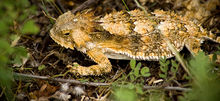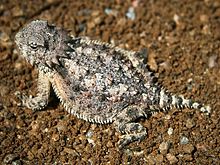Regal horned lizard: Difference between revisions
| Line 33: | Line 33: | ||
==Habitat== |
==Habitat== |
||
This horned lizard occupies primarily level or gently sloping terrain with openly spaced [[desert]] vegetation such as [[mesquite]], [[creosote bush]], and [[saguaro]] cactus.<ref>[http://uts.cc.utexas.edu/~varanus/phryno.html UTexas.edu]</ref> |
This horned lizard occupies primarily level or gently sloping terrain with openly spaced [[desert]] vegetation such as [[mesquite]], [[creosote bush]], and [[saguaro]] cactus.<ref>[http://uts.cc.utexas.edu/~varanus/phryno.html UTexas.edu]</ref> |
||
Can be found primarily in a hot and dry climate where the Earth is may be covered in limestone dust<ref>{{cite book|last1=Suarez|first1=Andrew|last2=Richmond|first2=Jon|last3=Case|first3=Ted|title=Prey Selection in Horned Lizards Following the Invasion of Argentine Ants in Southern California|edition=10}}</ref> |
|||
==Diet== |
==Diet== |
||
Revision as of 15:29, 15 December 2014
| Regal horned lizard | |
|---|---|

| |
| Phrynosoma solare | |
| Scientific classification | |
| Kingdom: | |
| Phylum: | |
| Subphylum: | |
| Class: | |
| Order: | |
| Suborder: | |
| Family: | |
| Genus: | |
| Species: | P. solare
|
| Binomial name | |
| Phrynosoma solare | |

The regal horned lizard (Phrynosoma solare) is a horned lizard species native to Mexico and the Southwest United States.[2]
Description
The regal horned lizard is a small, flat lizard about the size of the palm of a man's hand. Though it has spikes all around its body, the regal horn’s main defense is the ability to squirt blood from its eyes.
3-4 inches in length from nose to tail as a full adult.
Pale grey to yellow-brown or reddish topped with dark blotches along side the body and back.
4 legs each leg with 4 toes and claws on each leg.
Distribution
This lizard can be found across southeastern Arizona and along the transition of the southern zone of the central mountains region.[3]
Habitat
This horned lizard occupies primarily level or gently sloping terrain with openly spaced desert vegetation such as mesquite, creosote bush, and saguaro cactus.[4]
Can be found primarily in a hot and dry climate where the Earth is may be covered in limestone dust[5]
Diet
They eat mostly harvester ants, and can eat twenty-five hundred ants in one meal. They are slow eaters, because they spend most of their time in the intense heat of the desert during meals.[6]
Behavior
This is a year-round active type of lizard, but during winter, its activity is usually restricted to unseasonably warm days. It looks for shelter from cold temperatures by digging holes in the ground. When it is threatened or captured, it squirts blood from its eye. This blood may have a taste used to deter predators. Some other defensive behaviors include gulping air and poking with the horns.
Reproduction
During summer, they can lay up to 33 eggs in a nest excavated in loose soil. The nest is a small chamber at the end of an 14’-in-long tunnel.
References
- ^ ZipcodeZoo.com
- ^ UTexas.edu
- ^ http://www.reptilesofaz.org/Lizards-Subpages/h-p-solare.html
- ^ UTexas.edu
- ^ Suarez, Andrew; Richmond, Jon; Case, Ted. Prey Selection in Horned Lizards Following the Invasion of Argentine Ants in Southern California (10 ed.).
- ^ Nature’s Monsters: Lizards, Brenda Ralph Lewis, Gareth Stevens publishing,2006, p. 20-21) Lewis, Brenda (2006). Natures Monsters: Lizards. Milwaukee, WI, USA: Gareth Stevens Publishing. pp. 20–21. ISBN 978-0-8368-6363-5.
External links
